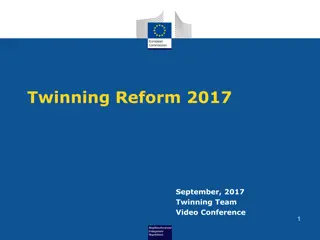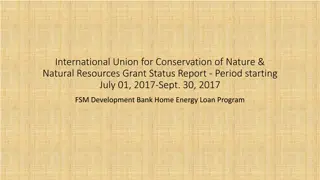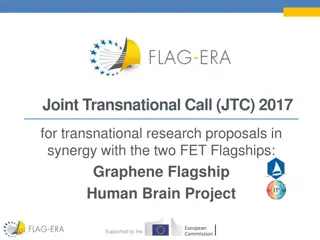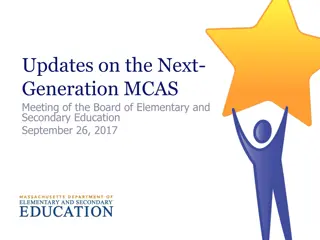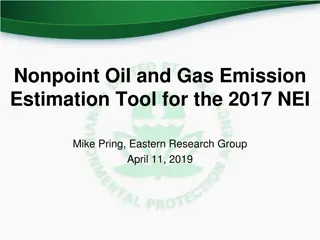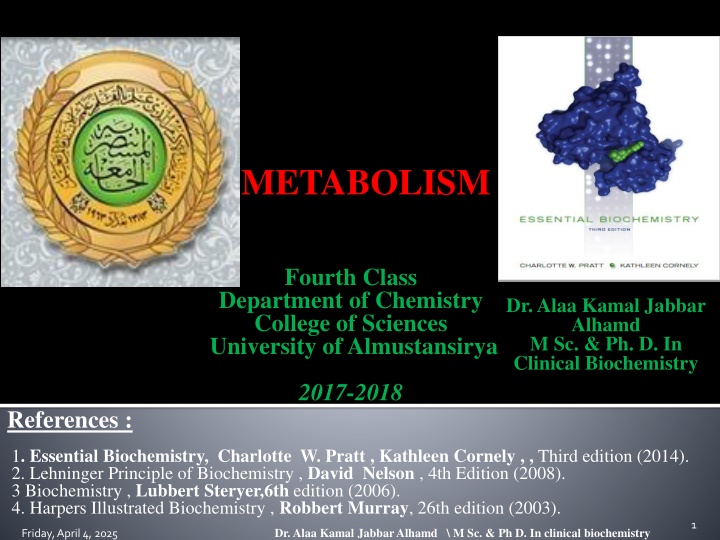
Metabolism and Bioenergetics in Biochemistry Studies
Explore the intricate world of metabolism and bioenergetics in biochemistry, delving into topics such as metabolic pathways, free energy changes, and cellular structures. Learn about the laws of thermodynamics, peptide bonds, lipid molecules, trophic strategies, and the interconnectedness of metabolic reactions in living organisms.
Download Presentation

Please find below an Image/Link to download the presentation.
The content on the website is provided AS IS for your information and personal use only. It may not be sold, licensed, or shared on other websites without obtaining consent from the author. If you encounter any issues during the download, it is possible that the publisher has removed the file from their server.
You are allowed to download the files provided on this website for personal or commercial use, subject to the condition that they are used lawfully. All files are the property of their respective owners.
The content on the website is provided AS IS for your information and personal use only. It may not be sold, licensed, or shared on other websites without obtaining consent from the author.
E N D
Presentation Transcript
METABOLISM Fourth Class Department of Chemistry College of Sciences University of Almustansirya Dr. Alaa Kamal Jabbar Alhamd M Sc. & Ph. D. In Clinical Biochemistry 2017-2018 References : 1. Essential Biochemistry, Charlotte W. Pratt , Kathleen Cornely , , Third edition (2014). 2. Lehninger Principle of Biochemistry , David Nelson , 4th Edition (2008). 3 Biochemistry , Lubbert Steryer,6th edition (2006). 4. Harpers Illustrated Biochemistry , Robbert Murray, 26th edition (2003). Friday, April 4, 2025 Dr. Alaa Kamal Jabbar Alhamd \ M Sc. & Ph D. In clinical biochemistry 1
METABOLISM AND BIOENERGETICS Dr. Alaa Kamal Jabbar Alhamd \ M Sc. & Ph D. In clinical biochemistry Friday, April 4, 2025 2
Syllabus METABOLISM AND BIOENERGETICS Food and Fuel Cells take up the products of digestion Monomers are stored as polymers Fuels are mobilized as needed Metabolic Pathways Some major metabolic pathways share a few common intermediates Metabolic pathways are complex Free Energy Changes in Metabolic Reactions The free energy change depends on reactant concentrations Unfavorable reactions are coupled to favorable reactions Free energy can take different forms Regulation occurs at the steps with the largest free energy changes Dr. Alaa Kamal Jabbar Alhamd \ M Sc. & Ph D. In clinical biochemistry Friday, April 4, 2025 3
We do to remember that : Living organisms obey the laws of thermodynamics . Amino acids are linked by peptide bonds to form a polypeptide . Allosteric regulators can inhibit or activate enzymes . Lipids are predominantly hydrophobic molecules that can be esterified but cannot form polymers . Monosaccharides can be linked by glycosidic bonds in various arrangements . Some organisms, known as chemoautotrophsobtain virtually all their metabolic building materials and free energy from the simple inorganic compounds CO2, N2, H2, and S2. Photoautotrophs , such as the familiar green plants, need little more than CO2, H2O, a source of nitrogen, and sunlight. In contrast, heterotrophs, a group that includes animals, directly or indirectly obtain all their building materials and free energy from organic compounds produced by chemo- or photoautotrophs. Despite their different trophic strategies, all organisms have remarkably similar cellular structures, make the same types of biomolecules, and use Friday, April 4, 2025 similar enzymes to build and break down those molecules. Dr. Alaa Kamal Jabbar Alhamd \ M Sc. & Ph D. In clinical biochemistry 4
Cells catabolize large molecules to release free energy and small molecules. The cells then use the free energy and small molecules to rebuild larger molecules, a process called anabolism. break down or The set of all catabolic and anabolic activities constitutes an organism s metabolism. A catalog of all the metabolic reactions undertaken by plants, animals, and bacteria. To introduce a few of the major molecular players in metabolism, including their precursors and degradation products, and further explore the meaning of free energy in biological systems. Catabolic (degradative) reactions yield free energy and small molecules that can be used for anabolic (synthetic) reactions. Metabolism is the sum of all catabolic and anabolic processes. Dr. Alaa Kamal Jabbar Alhamd \ M Sc. & Ph D. In clinical biochemistry Friday, April 4, 2025 5
Food and Fuel As heterotrophs, mammals rely on food produced by other organisms. After food is digested and absorbed, it becomes a source of metabolic energy and materials to support the animal s growth and other activities. The human diet includes the four types of biological molecules. These molecules are often present as macromolecular polymers, namely proteins , nucleic acids, polysaccharides, and triacylglycerols (Not polymers since the monomeric units are not linked to each other but to glycerol). Digestion reduces the polymers to their monomeric components: amino acids, nucleotides, monosaccharides, and fatty acids. The breakdown of nucleotides does not yield significant amounts of metabolic free energy, To devote more attention to the catabolism of other types of biomolecules. NOTE, The macromolecules in food are hydrolyzed, and the monomeric products are absorbed by the intestine. Cells store fatty acids, glucose, and amino acids in the form of polymers. And Metabolic fuels can be mobilized by breaking down glycogen, triacylglycerols, and proteins. Dr. Alaa Kamal Jabbar Alhamd \ M Sc. & Ph D. In clinical biochemistry Friday, April 4, 2025 6
Cells take up the products of digestion Digestion takes place extra cellularly in the mouth, stomach, and small intestine and is catalyzed by hydrolytic enzymes. For example, salivary amylase beginsto break down starch, which consists of linear polymers of glucose residues (amylose) and branched polymers. Gastric and pancreatic proteases (including trypsin, chymotrypsin, and elastase) degrade proteins to small peptides and amino acids. Lipases synthesized by the pancreas and secreted into the small intestine catalyze the release of fatty acids from triacylglycerols. Water insoluble lipids do not freely mix with the other digested molecules but instead form micelles. The products of digestion are absorbed by the cells lining the intestine. Monosaccharides enter the cells via active transporters such as the Na1- glucose system. Similar symport systems bring amino acids and di- and tripeptides into the cells. Some highly hydrophobic lipids diffuse through the cell membrane; others require transporters. Inside the cell, the triacylglycerol digestion Dr. Alaa Kamal Jabbar Alhamd \ M Sc. & Ph D. In clinical biochemistry Friday, April 4, 2025 7
Digestion of biopolymers. These hydrolytic reactions are just a few of those that occur during food digestion. In each example, the bond to be cleaved is colored red. (a) The chains of glucose residues in starch are hydrolyzed by amylases. (b) Proteases catalyze the hydrolysis of peptide bonds in proteins. (c) Lipases hydrolyze the ester bonds linking fatty acids to the glycerol backbone of triacylglycerols. Dr. Alaa Kamal Jabbar Alhamd \ M Sc. & Ph D. In clinical biochemistry Friday, April 4, 2025 8
products re-form triacylglycerols, and some fatty acids are linked to cholesterol to form cholesteryl esters, for example, Triacylglycerols and cholesteryl esters are packaged, together with specific proteins, to form lipoproteins. These particles, known specifi cally as chylomicrons, are releasedinto the lymphatic circulation before entering the bloodstream for delivery to tissues. Dr. Alaa Kamal Jabbar Alhamd \ M Sc. & Ph D. In clinical biochemistry Friday, April 4, 2025 9
Water-soluble substances such as amino acids and monosaccharides leave the intestinal cells and enter the portal vein, which drains the intestine and other visceral organs and leads directly to the liver. The liver therefore receives the bulk of a meal s nutrients and catabolizes them, stores them, or releases them back into the bloodstream. The liver also takes up chylomicrons and repackages the lipids with different proteins to form other lipoproteins, which circulate throughout the body, carrying cholesterol, triacylglycerols, and other lipids (lipoproteins). The location of resources following a meal varies with the individual s needs at that time and with the type of nutrients consumed. Fortunately, the body does this efficiently, regardless of what food was eaten. Dr. Alaa Kamal Jabbar Alhamd \ M Sc. & Ph D. In clinical biochemistry Friday, April 4, 2025 10
Dietary Guidelines Nutritionists have yet to come up with the ideal diet; the best they can do is identify the body s overall needs and roughly outline dietary requirements. For example, scientists have compiled lists of recommended daily intakes for various substances in terms of grams of the substance or the proportion of total energy intake contributed by that substance: Distribution of Macronutrients for Adults % Carbohydrate Fat Protein 45 65% 20 35% 10 35% However, few foods are composed of pure substances, so more practical guidelines focus on types of foods, with units that are more familiar to most consumers, such as ounces or cups. One source of information is the U.S. Department of Agriculture, which has published the following guidelines: Dr. Alaa Kamal Jabbar Alhamd \ M Sc. & Ph D. In clinical biochemistry Friday, April 4, 2025 11
Food Group Choices Moderately active female, age 21 25 Moderately active Male,age 21-25 Total calories 2200 2800 Fruits 2cups 2.5 cups Grains 7oz 10oz Milk Products 3cups 3cups Meat,Beams,Nuts 6oz 7oz Oils 6tsp 8tsp Vegetables 3cups 3.5cups Dr. Alaa Kamal Jabbar Alhamd \ M Sc. & Ph D. In clinical biochemistry Friday, April 4, 2025 12
Even these recommendations are somewhat clumsy, since most individuals do not determine the volume or mass of what they place on their plates. Nutrition educators strive to translate some formal quantities into yet more familiar units: A cup of rice or a medium apple is about the size of a baseball, and three ounces of meat is about the size of a deck of cards. Finally, a serious challenge for anyone interested in tracking their nutrient consumption is that many foods are processed; that is, raw ingredients are combined, sometimes in unknown proportions, to generate a product that can be sold as a convenience item (think: instant soup). Such foods are typically accompanied by a nutrition facts label that lists, among other things, the serving size; calories per serving; and the quantities of carbohydrates, fats, and proteins (in grams) and their percentage of the recommended daily value. Dr. Alaa Kamal Jabbar Alhamd \ M Sc. & Ph D. In clinical biochemistry Friday, April 4, 2025 13
The availability of different types of dietary guidelines, along with a plethora of advice (which may or may not be grounded in the scientific method), suggests that there is significant leeway regarding what humans can or should consume. Indeed, consideration of how eating patterns have varied across centuries and across continents indicates that the human body must be remarkably versatile in converting a variety of raw materials into the molecular building blocks and metabolic energy required to sustain life. Dr. Alaa Kamal Jabbar Alhamd \ M Sc. & Ph D. In clinical biochemistry Friday, April 4, 2025 14
Monomers are stored as polymers A meal, the circulating concentrations of monomeric compounds are relatively high. All cells can take up these materials to some extent to fulfill their immediate needs, but some tissues are specialized for the long-term storage of nutrients. For example, fatty acids are used to build triacylglycerols, many of which travel in the form of lipoproteins to adipose tissue. Here, adipocytes take up the triacylglycerols and store them as intracellular fat globules. Because the mass of lipid is hydrophobic and does not interfere with activities in the aqueous cytoplasm, the fat globule can be enormous, occupying most of the volume of the adipocyte .Adipocyte cells which make up adipose tissue, contain a small amount of cytoplasm surrounding a large globule of triacylglycerols (fat).Virtually all cells can take up monosaccharides and immediately catabolize them to produce free energySome tissues, primarily liver and muscle (which makes up a signifi cant portion of the human body), use monosaccharides to synthesize glycogen, the storage polymer of glucose. Dr. Alaa Kamal Jabbar Alhamd \ M Sc. & Ph D. In clinical biochemistry Friday, April 4, 2025 15
Amino acids can be used to build polypeptides. A protein is not a dedicated storage molecule for amino acids, as glycogen is for glucose and triacylglycerols are for fatty acids, so excess amino acids cannot be saved for later. However, in certain cases, such as during starvation, proteins are catabolized to supply the body s energy needs. If the intake of amino acids exceeds the body s immediate protein-building needs, the excess amino acids can be broken down and converted to carbohydrate (which can be stored as glycogen) or converted to acetyl units (which can then be converted to fat).Amino acids and glucose are both required to synthesize nucleotides. Asp, Gln, and Gly supply some of the carbon and nitrogen atoms used to build the purine and pyrimidine bases. The ribose-5-phosphate component of nucleotides is derived from glucose by a pathway that converts the six-carbon sugar to a five-carbon sugar. In sum, the allocation of resources within a cell depends on the type of tissue and its need to build cellular structures, provide free energy, or stockpile resources in anticipation of future needs. Dr. Alaa Kamal Jabbar Alhamd \ M Sc. & Ph D. In clinical biochemistry Friday, April 4, 2025 16
Fuels are mobilized as needed Amino acids, monosaccharides, and fatty acids are known as metabolic fuels because they can be broken down by processes that make free energy available for the cell s activities. After a meal, free glucose and amino acids are catabolized to release their free energy. When these fuel supplies are exhausted, the body mobilizes its stored resources; that is, it converts its polysaccharide and triacylglycerol storage molecules (and sometimes proteins) to their respective monomeric units. Most of the body s tissues prefer to use glucose as their primary metabolic fuel, and the central nervous system can run on almost nothing else. In response to this demand, the liver mobilizes glucose by breaking down glycogen. In general, depolymerization reactions are hydrolytic, but in the case of glycogen, the molecule that breaks the bonds between glucose residues is not water but phosphate. Thus, the degradation of glycogen is called phosphorolysis. This reaction is catalyzed by glycogen phosphorylase, which releases residues from the ends of branches in the glycogen polymer. Dr. Alaa Kamal Jabbar Alhamd \ M Sc. & Ph D. In clinical biochemistry Friday, April 4, 2025 17
The phosphate group of glucose-1-phosphate is removed before glucose is released from the liver into the circulation. Other tissues absorb glucose from the blood. In the disease diabetes mellitus, this does not occur, and the concentration of circulating glucose may become elevated. Dr. Alaa Kamal Jabbar Alhamd \ M Sc. & Ph D. In clinical biochemistry Friday, April 4, 2025 18
Metabolic Pathways The interconversion of a biopolymer and its monomeric units is usually accomplished in just one or a few enzyme-catalyzed steps. In contrast, many steps are required to break down the monomeric compounds or build them up from smaller precursors. These series of reactions are known as metabolic pathways. A metabolic pathway can be considered as a series of intermediates or metabolites, as a set of enzymes that catalyze the reactions by which metabolites are interconverted, as an energy-producing or energy-requiring phenomenon, or as a dynamic process whose activity can be turned up or down. Some intermediates resulting from glucose catabolism. Dr. Alaa Kamal Jabbar Alhamd \ M Sc. & Ph D. In clinical biochemistry Friday, April 4, 2025 19
Some major metabolic pathways share a few common intermediates One of the challenges of studying metabolism is dealing with the large number of reactions that occur in a cell involving thousands of different intermediates. However,a handful of metabolites appear as precursors or products in the pathways that lead to or from virtually all other types of biomolecules.In glycolysis, the pathway that degrades the monosaccharide glucose, the sixcarbon sugar is phosphorylated and split in half, yielding two molecules of glyceraldehyde-3-phosphate. Which is converted in several more steps to another three-carbon molecule, pyruvate. The decarboxylation of pyruvate yields acetyl-CoA, in which a two carbon acetyl group is linked to the carrier molecule coenzyme A (CoA). Glyceraldehyde-3-phosphate, pyruvate, and acetyl-CoA are key players in other metabolic pathways. For example, glyceraldehyde-3-phosphate is the metabolic precursor of the three-carbon glycerol backbone of triacylglycerols. Dr. Alaa Kamal Jabbar Alhamd \ M Sc. & Ph D. In clinical biochemistry Friday, April 4, 2025 20
In plants, it is also the entry point for the carbon fixed by photosynthesis; in this case, two molecules of glyceraldehyde-3- phosphate combine to form a six-carbon monosaccharide. Pyruvate can undergo a reversible amino-group transfer reaction to yield alanine. This makes pyruvate both a precursor of an amino acid and the degradation product of one. Pyruvate can also be carboxylated to yield oxaloacetate, a four- carbon precursor of several other amino acids: Dr. Alaa Kamal Jabbar Alhamd \ M Sc. & Ph D. In clinical biochemistry Friday, April 4, 2025 21
Fatty acids are built by the sequential addition of two-carbon units derived from acetyl-CoA; fatty acid breakdown yields acetyl-CoA.. If not used to synthesize other compounds, two-carbonintermediates can be broken down to CO2 by the citric acid cycle, a metabolic pathway essential for the catabolism of all metabolic fuels. Dr. Alaa Kamal Jabbar Alhamd \ M Sc. & Ph D. In clinical biochemistry Friday, April 4, 2025 22
Many metabolic pathways include oxidationreduction reactionsIn general, the catabolism of amino acids, monosaccharides, and fatty acids is a process of oxidizing carbon atoms, and the synthesis of these compounds involves carbon reduction. Thatoxidation is defined as the loss of electrons and reduction is the gain of electrons. Oxidation reduction, or redox, reactions occur in pairs so that as one compound becomes more oxidized (gives up electrons or loosens its hold on them), another compound becomes reduced (receives the electrons or tightens its grip on them). The redox-active portion of NAD+ and NADP+ is the nicotinamide group, which accepts a hydride ion to form NADH or NADPH. Dr. Alaa Kamal Jabbar Alhamd \ M Sc. & Ph D. In clinical biochemistry Friday, April 4, 2025 23
The reaction is reversible, so the reduced cofactors can become oxidized by giving up a hydride ion. In general, NAD+ participates in catabolic reactions and NADP+ in anabolic reactions. Because these electron carriers are soluble in aqueous solution, they can travel throughout the cell, shuttling electrons from reduced compounds to oxidized compounds. Many cellular oxidation reduction reactions take place at membrane surfaces, for example, in the inner membranes of mitochondria and chloroplasts in eukaryotesand in the plasma membrane of prokaryotes. In these cases, a membrane-associatedenzyme may transfer electrons from a substrate to a lipid-soluble electron carrier such as ubiquinone (coenzyme Q . Ubiquinone s hydrophobic tail, containing 10 five- carbon isoprenoid units in mammals, allows it to diffuse within the membrane. Ubiquinone can take up one or two electrons (in contrast to NAD+, which is strictly a two-electron carrier). A one-electron reduction of ubiquinone (addition of an H atom) produces a semiquinone, a stable free radical as QH . A two-electron reduction (two H atoms) yields ubiquinol (QH2): Dr. Alaa Kamal Jabbar Alhamd \ M Sc. & Ph D. In clinical biochemistry Friday, April 4, 2025 24
The reduced ubiquinol can then diffuse through the membrane to donate its electrons in another oxidation reduction reaction. Catabolic pathways, such as the citric acid cycle, generate considerable amounts of reduced cofactors. Some of them are reoxidized in anabolic reactions. The rest are reoxidized by a process that is accompanied by the synthesis of ATP from ADP and Pi. In mammals, the reoxidation of NADH and QH2 and the concomitant production of ATP require the reduction of O2 to H2O. This pathway is known as oxidative phosphorylation. Dr. Alaa Kamal Jabbar Alhamd \ M Sc. & Ph D. In clinical biochemistry Friday, April 4, 2025 25
In effect, NAD+ and ubiquinone collect electrons (and hence free energy) from reduced fuel molecules. When the electrons are ultimately transferred to O2, this free energy is harvested in the form of ATP. Dr. Alaa Kamal Jabbar Alhamd \ M Sc. & Ph D. In clinical biochemistry Friday, April 4, 2025 26
Metabolic pathways are complex The metabolic pathway intermediates can be further degraded (catabolic or oxidized) and their electrons collected by cofactors. The anabolic reactions in which the common two- and three carbon intermediates give rise to larger compounds. The information in below schematic form in order to highlight some important features of metabolism. 1. Metabolic pathways are all connected. 2. Pathway activity is regulated. 3. Not every cell carries out every pathway. 4. Each cell has a unique metabolic repertoire. In addition to the pathways 5. Organisms may be metabolically interdependent. (synthetic) Dr. Alaa Kamal Jabbar Alhamd \ M Sc. & Ph D. In clinical biochemistry Friday, April 4, 2025 27
The free energy change depends on reactant concentrations The change in free energy of a system is related to the concentrations of the reacting substances. When a reaction such as A + B C + D is at equilibrium, the concentrations of the four reactants define the equilibrium constant, K eq, for the reaction: K eq = [C]eq [D]eq / [A]eq [B]eq When the system is not at equilibrium, the reactants experience a driving force to reach their equilibrium values. This force is the standard free energy change for the reaction, G 0 ,, which is defined as G 0 , = - RT ln K eq R is the gas constant (8.3145 J . K-1 . Mol-1) and T is the temperature in Kelvin. The free energy has units of joules per mole . Equation can be used to calculate G 0 , from K eq and vice versa Dr. Alaa Kamal Jabbar Alhamd \ M Sc. & Ph D. In clinical biochemistry Friday, April 4, 2025 28
Like Keq, G 0 , is a constant for a particular reaction. It may be a positive or negative value, and it indicates whether the reaction can proceed spontaneously ( G 0 , < 0) or not ( G 0 . > 0) under standard conditions. In a living cell, reactants and products are almost never present at standard-state concentrations and the temperature may not be 250C, yet reactions do occur with some change in free energy. Thus, it is important to distinguish the standard free energy change of a reaction from its actual free energy change, G . G is a function of the actual concentrations of the reactants and the temperature (370C or 310 K in humans). G is related to the standard free energy change for the reaction: G = G 0 + RT ln [C][D] / [A][B] K eq = [C]eq [D]eq / [A]eq [B]eq Here, the bracketed quantities represent the actual, nonequilibrium concentrations of the reactants. The concentration term in above equation is sometimes called the mass action ratio. When the reaction is at equilibrium, G = 0 and G 0, = - RT ln [C]eq [D]eq / [A]eq [B]eq the criterion for spontaneity for a reaction is G, a property of the actual Friday, April 4, 2025 concentrations of the reactants, not the constant G 0, Dr. Alaa Kamal Jabbar Alhamd \ M Sc. & Ph D. In clinical biochemistry 29
Unfavorable reactions are coupled to favorable reactions A biochemical reaction may at first seem to be thermodynamically forbidden because its free energy change is greater than zero. Yet the reaction can proceed in vivo when it is coupled to a second reaction whose value of G is very large and negative so that the net change in free energy for the combined reactions is less than zero. ATP is often involved in such coupled processes because its reactions occur with a relatively large negative change in free energy.Adenosine triphosphate (ATP) contains two phosphoanhydride bonds. Cleavage of either of these bonds that is, transfer of one or two of its phosphorylgroups to another molecule is a reaction with a large negative standard free energy change (under physiological conditions, G is even more negative). As a reference point, biochemists use the reaction in which a phosphoryl group is transferred to water in other words, hydrolysis of the phosphoanhydride bond, such as ATP + H2O ADP + Pi Dr. Alaa Kamal Jabbar Alhamd \ M Sc. & Ph D. In clinical biochemistry Friday, April 4, 2025 30
Adenosine triphosphate. The three phosphate groups are sometimes described by the Greek letters , , and . The linkage between the first ( ) and second ( ) phosphoryl groups, and second ( ) and third ( ), is a phosphoanhydride reaction in which one or two phosphoryl transferred compound (a reaction in which a phosphoanhydride bond is cleaved) has a large negative value of G0, between the bond. A groups to are another Dr. Alaa Kamal Jabbar Alhamd \ M Sc. & Ph D. In clinical biochemistry Friday, April 4, 2025 31
This is one reason why ATP is commonly called the energy currency of the cell. The general role of ATP in linking exergonic ATP-producing processes to endergonic ATP-consuming processes can be diagrammed as In this scheme, it appears that the energy of the catabolized nutrient is transferred to ATP, then the energy of ATP is transferred to another product in a biosynthetic reaction. However, free energy is not a tangible item, and there is nothing magic about ATP, as the question at the start of the chapter indicates. The two phosphoanhydride bonds of ATP are sometimes called high-energy bonds, but they are no different from other covalent bonds. Friday, April 4, 2025 32
All that matters is that breaking these bonds is a process with a large negative free energy change. Using the simple example of ATP hydrolysis, we can state that a large amount of free energy is released when ATP is hydrolyzed because the products of the reaction have less free energy than the reactants. It is worth examining two reasons why this is so. 1. The ATP hydrolysis products are more stable than the reactants. At physiological pH, ATP has three to four negative charges (its pK is close to 7), and the anionic groups repel each other. In the products ADP and Pi, separation of the charges relieves some of this unfavorable electrostatic repulsion. 2. A compound with a phosphoanhydride bond experiences less resonance stabilization than its hydrolysis products. Resonance stabilization reflects the degree of electron delocalization in a molecule and can be roughly assessed by the number of different ways of depicting the molecule s structure. There are fewer equivalent ways of arranging the bonds of the terminal phosphoryl group of ATP than there are in free Pi. Dr. Alaa Kamal Jabbar Alhamd \ M Sc. & Ph D. In clinical biochemistry Friday, April 4, 2025 33
Free energy can take different forms ATP is not the only substance that functions as energy currency in the cell. Other compounds that participate in reactions with large negative changes in free energy can serve the same purpose. For example, a number of phosphorylated compounds other than ATP can give up their phosphoryl group to another molecule. Although hydrolysis of the bond linking the phosphate group to the rest of the molecule could be a wasteful process (the product would be free phosphate, Pi), phosphocreatine has a standard free energy of hydrolysis of -43.1 kJ . Mol-1 and Creatine has lower free energy than phosphocreatine since it has two, rather than one, resonance forms; this resonance stabilization contributes to the large negative free energy change when phosphocreatine transfers its phosphoryl group to another compound. In muscles, phosphocreatine transfers a Friday, April 4, 2025 phosphoryl group to ADP to produceATP Dr. Alaa Kamal Jabbar Alhamd \ M Sc. & Ph D. In clinical biochemistry 34
Another class of compounds that can release a large amount of free energy upon hydrolysis are thioesters, such as acetyl-CoA. Coenzyme A is a nucleotide derivative with a side chain ending in a sulfhydryl (SH) group. An acyl or acetyl group (the A for which coenzyme A was named) is linked to the sulfhydryl group by a thioester bond. Hydrolysis of this bond has a G0,value of 231.5 kJ . Mol-1, comparable to that of ATP hydrolysis: Hydrolysis of a thioester is more exergonic than the hydrolysis of an ordinary (oxygen) ester because thioesters have less resonance stability than oxygen esters, owing to the larger size of an S atom relative to an O atom. An acetyl group linked to coenzyme A can be readily transferred to another molecule because formation of the new linkage is powered by the favorable free energy change of breaking the thioester bond. Dr. Alaa Kamal Jabbar Alhamd \ M Sc. & Ph D. In clinical biochemistry Friday, April 4, 2025 35
Already seen that in oxidationreduction reactions, cofactors such as NAD+ and ubiquinone can collect electrons. The reduced cofactors are a form of energy currency because their subsequent reoxidation by another compound occurs with a negative change in free energy. Ultimately, the transfer of electrons from one reduced cofactor to another and finally to oxygen, the final electron acceptor in many cells, releases enough free energy to drive the synthesis of ATP. The free energy changes occur not just as the result of chemical changes such as phosphoryl-group transfer or electron transfer. As decreed by the first law of thermodynamics, energy can take many forms. We will see that ATP production in cells depends on the energy of an electrochemical gradient, that is, an imbalance in the concentration of a substance (protons) on the two sides of a membrane. The free energy change of dissipating this gradient is converted to the mechanical energy of an enzyme that synthesizes ATP. In photosynthetic cells, the chemical reactions required to generate carbohydrates are ultimately driven by the free energy changes of reactions in which light-excited molecules return to a lower-energy state Dr. Alaa Kamal Jabbar Alhamd \ M Sc. & Ph D. In clinical biochemistry Friday, April 4, 2025 36
Regulation occurs at the steps with the largest free energy changes Reactions with large changes in free energy have a longer way to go to reach equilibrium; these are the reactions that experience the greatest urge to proceed forward. However, the enzymes that catalyze these reactions do not allow the reaction to reach equilibrium because they work too slowly. Often the enzymes are already saturated with substrate, so the reactions cannot go any faster (when [S] >>> KM, v Vmax;). The rates of these far-from-equilibrium reactions limit flux through the entire pathway because the reactions function like dams. Dr. Alaa Kamal Jabbar Alhamd \ M Sc. & Ph D. In clinical biochemistry Friday, April 4, 2025 37
Cells can regulate flux through a pathway by adjusting the rate of a reaction with a large free energy change. This can be done by increasing the amount of enzyme that catalyzes that step or by altering the intrinsic activity of the enzyme through allosteric mechanisms. As soon as more metabolite has gotten past the dam, the near-equilibrium reactions go with the flow, allowing the pathway intermediates to move toward the final product. Most metabolic pathways do not have a single flow-control point, as the dam analogy might suggest. Instead, flux is typically controlled at several points to ensure that the pathway can work efficiently as part of the cell s entire metabolic network. Dr. Alaa Kamal Jabbar Alhamd \ M Sc. & Ph D. In clinical biochemistry Friday, April 4, 2025 38


